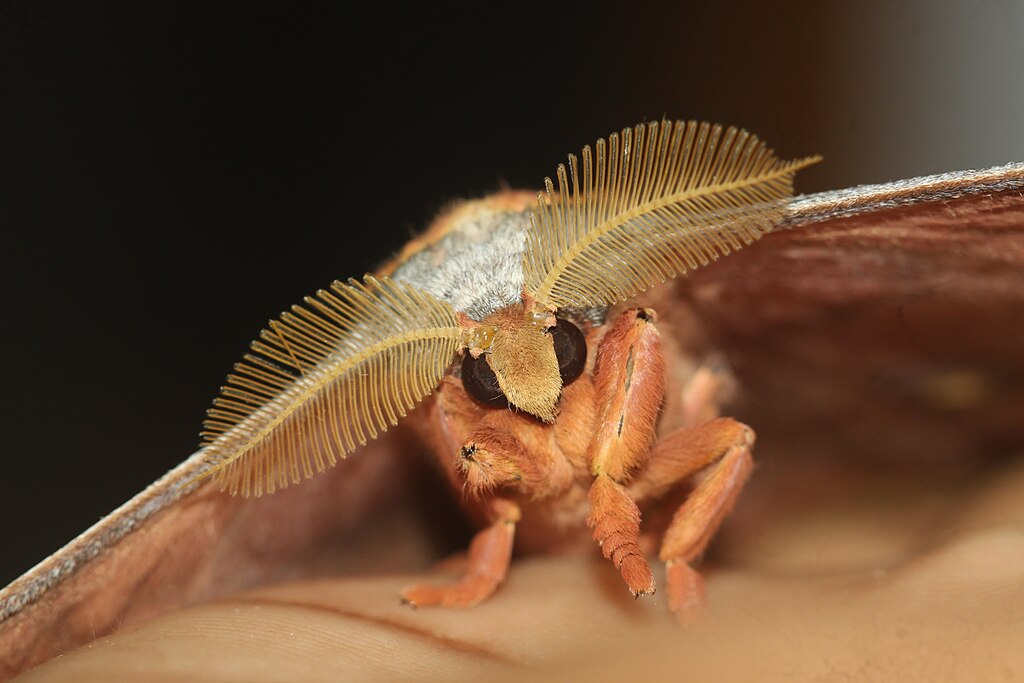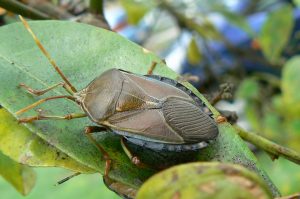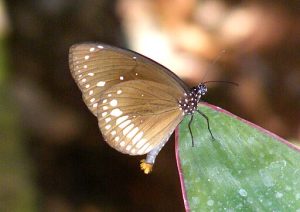10 Semiochemicals

Semiochemicals are signalling chemicals. Insects produce them to communicate with members of their own species. They produce them to interact with other insect species. Insects react to chemicals produced by plants, using them for orientation to hosts or away from deterrent compounds.
Learning Objectives
- Know the main types of signalling interactions within and between species
- Appreciate the diversity of signals and their different functions
- Understand how egg fertilization occurs and know the main sex determination mechanisms
- Be familiar with the important roles of sex pheromones in insect biology
Overview of Semiochemicals
Semiochemicals are chemicals used as signals: after they are detected, they alter the behaviour or physiology of the receiver. Semiochemicals encompass a significant part of the spectrum of sensory modalities that can be received by insects. Semiochemicals can be detected by olfaction, taste and internal sensory receptors but by their definition cannot include tactile and visual signals.
Semiochemicals do not encompass chemical signals from abiotic aspects of the environment.
Feeding and mating are the major behaviours that utilise semiochemicals. Semiochemicals can be intraspecific or interspecific (intra=within, inter=between). Interspecific chemicals can be signals that originate from a plant and affect an animal, or they can originate from one animal or plant species and affect another.
Interspecific signals are divided into two categories: allomones and kairomones, based on the direction of the signalling.
The obvious existence of coevolution in the use and purpose of signals makes them relevant to:
- evolutionary studies
- ecology
- sexual selection
- pest control
Types of Semiochemicals
- Pheromones – intraspecific signalling
- Kairomones – interspecific signalling; the responder benefits
- Allomones – interspecific signalling; the sender benefits
Pheromones
Pheromones elicit a reaction from members of the sender’s species. Examples include the use of odours to attract or find members of the opposite sex and the use of the sense of taste in many flies where sex pheromones are distributed in the waxes of the cuticle and are detected by taste on contact.
Some specific types of pheromones include:
- sex pheromones
- aggregation pheromones, e.g. swarms, group attack on a plant resource, oviposition
- spacing pheromones, e.g. oviposition-deterrent pheromone in fruit flies
- trail-marking pheromones, e.g. ant trails
- alarm pheromones, e.g. bees
Kairomones
Kairomones elicit a behavioural or physiological reaction that is favourable to the receiver. For example, exploiters are attracted to chemicals produced by potential food or oviposition sites.
Some examples:
- Brassica plants produce sinigrin that probably originally evolved as an antifeedent (an allomone). The sinigrin attracts Pieris rapae (cabbage white) butterflies to lay their eggs.
- Lactic acid produced as a component of sweat is an attractant for mosquitoes.
- Predators or parasites home in on odours from the host.
Allomones
Allomones elicit a behavioural or physiological reaction that is favourable to the sender. An easy way to remember the name is to associate it with “alarm”. Any chemical that repels predators or parasites is an allomone. Allomone emission is often associated with aposematic colouration, i.e. bright colours, often yellow and black or red and black, that make the subject conspicuous. Examples include repellent odours and tastes such as the toxic cardiac glycosides of wanderer caterpillars mentioned in the chapter on feeding.
Venoms are allomones because they elicit a reaction favourable to the sender. Venoms can function as prey immobilisation chemicals and/or nest defense chemicals. Wasps use their venom for both functions, whereas honeybees use them only for defence. Some allomones are designed solely to repel vertebrates, such as the repugnatorial substance released by stink bugs.

For example, the bronze-orange bug thrives on citrus. Brushing against the bush or disturbing the insects results in them releasing a pungent-smelling liquid from gland reservoirs in their metathorax.
Bombardier beetles spray benzoquinones in an explosive burst. The fluid reaches high temperatures.and can be aimed toward the direction of a potential predator. Specialised glands produce secretions separately: when mixed, the temperature rises, gas forms, and causes explosive ejection of hot caustic fluid.
Check out this video of a bombardier beetle ejecting its “stink bomb!
Sex Pheromones
Finding mates can be difficult for some insects, especially if the population is widely dispersed. A sensitivity to odours allows upwind tracking in flight. Some insects can detect very low concentrations of odour allowing them to detect mates from far away. These long distance attractants are perhaps the best known examples. They are especially common in Lepidoptera and Coleoptera. Most often, the female releases the pheromone. Courtship pheromones are pheromonal signals that constitute a part of the mating process: places both partners in the appropriate behavioural and physiological state.
Sex Pheromones of Flies
In Diptera, sex pheromones are commonly derived from cuticular hydrocarbons. They do not have a high vapour pressure so are not effective at long distances. Rather, they serve at close-range or are contact-only because they are not highly volatile. They appear to be derived from the cuticular lipids of insects whose primary function is water-proofing.
Some Diptera secrete volatile pheromones. For example, female sandflies (Psychodidae: Lutzomyia) in South America transmit leishmaniasis: a disease where a protozoan parasite causes dermal lesions in humans. Males secrete terpenes acting as an attractant over several metres, attracting both males and females to leks (mating swarms). More specifically, it could be could be called an aggregation pheromone. Note: that these “real” sandflies are not related to what we commonly call sandflies in Australia which are better termed ‘biting midges’ (Diptera: Ceratopogonidae).
Fruitflies (Tephritidae) are noted for their complex mating behaviours . Males produce a secretion in anal pouches that are extruded and contents sprayed into the air using wings or legs. It has a nice fruity smell!
Blowflies (Australian sheep blowfly) have an oviposition pheromone: females cluster together at an oviposition site and all contribute to an extra-large batch of eggs that will hatch at the same time.
Gland Locations
Glands that produce semiochemicals can be found at almost any epidermal location. Commonly, specialised structures such as a specific gland with a reservoir release the semiochemicals. Sometimes they are associated with dispersal structures such as cuticular hairs with large surface area or even scales that are designed to be cast off to disperse the chemicals.
In female Lepidoptera, the sex pheromone glands are frequently in the terminal abdominal region, often in the soft intersegmental membrane between terminal abdominal segments. By arching the abdomen, they can control pheromone release. “Calling” is elicited by either (a) eversion of cuticle: females evert the sac and “call” at a particular time of night or (b) depressing tip of abdomen to reveal intersegmental membrane.
Some male Lepidoptera have “hair pencils” kept internalised in the abdomen. Glands open out at the base of the hairs. The hair pencils or the inverted sacs they sit on are everted during calling.

In Lepidoptera, the pheromone comprises blends of aliphatic straight-chain hydrocarbons, alcohols, acetates, aldehydes, and ketones. Some components are common to a genus but the specific blends and minor components differ.
Milkweed butterflies (Danainae, e.g. Danaus plexippus is the famous Monarch butterfly) males can release pheromone-carrying particles from gland-containing pockets on the wings. Others have special scales (androconia), often on the wings that break up and are released and dispersed. The androconia are lepidopteran scales that are specialised to carry scent. They have a large surface area at the tips.

In Diptera, the oenocytes, single-celled glands sitting under the cuticle, produce the pheromones.
Male accessory glands
Chemicals deposited into female during mating are technically pheromones. The secretions aid in transfer of sperm to spermathecae by producing oviduct contractions, as studied in the blood-sucking bug, Rhodnius.
In some cases, the male accessory gland secretions produce oviposition enhancement, shown in mosquitoes by implantation of male accessory gland in female abdomen.
Oocyte production and maturation can be accelerated in some insects after the act of mating, induced by male-derived chemicals.
Substances in the male accessory gland fluid terminate receptivity in female mosquitoes, Drosophila, houseflies, blowflies, as well as representatives from other orders. Return to receptivity occurs with time, or after multiple oviposition events, or after sperm depletion. In some cases, receptivity inhibition is due to the presence of sperm, while in others sperm don’t play a role. It is not known where they act, but they enter the haemolymph rapidly and presumably bind to receptor sites in the CNS.
Peptides with this function have been isolated in Drosophila and mosquitoes (called matrone in mosquitoes)–studied because of their potential uses in regulating pest insect reproduction. The problem is that peptides are notoriously difficult to manipulate into insects:
- Usually broken down in gut if digested
- Don’t penetrate cuticle
- Break down rapidly in environment
- Could possibly use engineered carrier viruses or transposable elements
Pheromones: Use in Pest Control
Advantages:
- Selective (no effect on beneficials)
- Non-toxic (delayed onset of resistance)
- Short-lived and non-polluting
Monitoring
The most extensive use of pheromones to date has been in monitoring for pest incursions. For example: quarantine and biosecurity officers check for presence/absence of pests, most often at ports. Pheromone traps give indications of pest density used for decision-making on when to spray or use other controls, i.e. to determine population density.
For the codling moth Cydia pomonella, sticky traps baited with pheromone are commonly used and placed in fruit trees at 1-4 per hectare. Traps attract males but there are problems with migration into trapping orchard from untreated, abandoned orchards.
Mass trapping
Aim is to reduce insect populations by attracting and killing insects, usually with insecticides or sticky traps.
Sex attractants
Not very useful as they only attract one sex: usually males in Lepidoptera, and typically only a few males are needed to fertilise many females.
Aggregation pheromones
- Useful in control of Spruce bark beetle in USA.
- Potential “lure and kill” for mosquitos: synthetic oviposition pheromone combined with growth regulator insecticide. Affects females which are the blood-feeding sex.
Mating Disruption
Permeating the atmosphere with sex attractant can cause sensory fatigue or compete with natural sources, or camouflage natural plumes. This technique has been successfully used in control of pink bollworm, oriental fruit moth, grape berry moth and artichoke plume moth.
The best use of mating disruption pheromones occurs when the insect has a short life span, a synchronised mating period and a short mating period.
Problems:
- Migration of mated individuals into treated area (growers’ groups and area-wide efforts are an advantage)
- Fecundity: in species producing many eggs, the small proportion that manage to mate may still produce sufficient progeny to cause pest problems
Would be better if the males attracted the females, then females could be trapped, removing them from the population. Otherwise escaping males can inseminate multiple females. This is almost the rule in Lepidoptera and many other insects.
Repellents
Using pheromones as repellents has limited commercial use. Trials have been done to repel beneficial insects from insecticide-treated areas, e.g. bees as pollinators are often killed, but can be repelled by treating the area with bee alarm pheromone.
Topic Review
Do you know…?
- Definitions of pheromones, allomones and kairomones
- Examples of the use of pheromones in insect pest control, including the advantages and drawbacks of their use
- Can you name at least 3 different types of insect pheromones and give examples of their use and the groups that use them
- What structural adaptations are present in Lepidoptera males and females that are associated with pheromone signalling and reception

